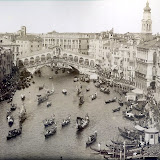Bridges in photographs, 1860s to 1970s
“Bridges are America’s cathedrals.”
Anon
Lovers meet on bridges, and when the love dies they jump off them. People come to bridges to lean over and stare into the darkness, contemplating difficult thoughts or emptying their minds; it’s much the same thing. Constantine discovered God on the Milvian Bridge; others have watched the tumbling rapids below or studied the cityscape and had visions every bit as profound. Bridges linked Buda to Pest and made them one. They cross the Bosphorus to join Europe to Asia. Long before people built cities, long before they built proper houses, they built bridges.
Admittedly, not every bridge is a thing of beauty but each of them requires ingenuity in the construction. The engineers have to think about load and stress, equilibrium, the geology below, the climate above, and then there are the economics. Anyone who has seen the famous 1940 footage of the Tacoma Narrows Bridge, twisting like a ribbon before it literally shatters under high winds, understands that the construction of a span across empty space requires detailed and rigorous thinking.
If bridges weren’t so important, there is no reason why they shouldn’t all look the same but they matter, so they can’t. Every major city must have its bridge as a symbol. Quite a few labourers lost their lives in the construction of the Brooklyn Bridge but when it was up New York could boast it had built its bridge basically out of wires. Eiffel designed the Maria Pia Bridge to cross the Douro River into Porto. It looks, not unsurprisingly, a little what his tower might if it blew over and fell across the Seine but Portugal didn’t just need a bridge it needed a stake in modernity. The three decades between 1850 and 1880 were a halcyon age in bridge building, bettered only by our own. Besides the Brooklyn and the Maria Pia we got the Széchenyi in Budapest and the Clifton Suspension Bridge in Bristol. Completed just outside this time frame, London’s Tower Bridge looks like a medieval anachronism alongside the sleek elegance of the others but it works like a clockwork toy. The greatest of them all was Scotland’s Forth Bridge, a statement that can only be challenged by someone who believes bridges must conform to a certain orthodoxy or that bombast and sophistication are necessarily opposites.
We think of homes as the centre of our lives but when bridges are destroyed entire communities are cut off. The effect is the same as being under siege except there is no enemy. A lifeline has gone. Military strategists have always known this. The first objective in an invasion is to gain control of the bridges, or demolish them. Without its bridges a city is crippled.
Bridges have always been natural subjects for photographers. Either they dominate the scene, a statement of human achievement, or they intrude quietly into the landscape as evidence of our presence. In Carlo Naya’s photograph of the Rialto Bridge in Venice, it is almost lost among the gondolas and canalfront edifices. It is nevertheless the central point of the composition, a way of saying the bridge is Venice; without it the city would be nothing. In the following image, by a M. Degano of Nice, the Pont St Louis has become absorbed into the rock face. Logic tells is it is a recent construction but it looks natural, as though it has been there forever. The people who collected the photographs for the Senior Service cigarette card series, a neglected contribution to the history of photography, understood that bridges were a celebration of Britain, its engineering triumphs and the pleasures of its cultivated landscapes. Amateurs, who once devoured instruction books on how to take perfect photos, have never needed guidance on how to photograph bridges. Instinctively we know where to stand to get the best view. It’s something we were doing before cameras were invented.
 |
| SOMEWHERE OVER THE RAINBOW |



No comments:
Post a Comment
Add comments here